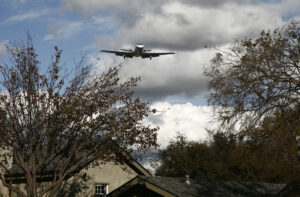
The City Council will make some important decisions about the future of Santa Monica Airport on Tuesday night.
Four items are on the agenda. Council is being asked to approve an administrative contract for book keeping, data management and landing fee collections; appropriate $672,525 for runway, parking and taxiway improvements; review a number of possible actions regarding future airport use and adjust aircraft landing fees.
City Hall's Phase III visioning process deals with numerous proposals for the future of the airport including identifying and taking action to reduce airport noise, air pollution and safety risks, revising leasing policies, raising aircraft landing fees and implementing restrictions on some operations.
Council will probably ask staff to assess the risks and benefits of closing all or a portion of the airport and return next March with an assessment of both actions. Staff's report would give the council the tools needed to ultimately determine whether City Hall should implement further changes that "would reduce airport impacts and enhance its benefit to the community" or close all or part of the airport after the expiration of its current aviation related obligations.
Aviation activity has generated many strident and vociferous complaints by neighbors north and west of the airport in Santa Monica as well as south and east of the airport in West Los Angeles. Most complaints are about aircraft noise and pollution come from people living under or near the east to west landing and take off patterns.
Last year, 102,675 aircraft operations were conducted at SMO. Some 12,414 involved jet planes. Jet landings and take-offs generate some of the most heated complaints as do the numerous non-jet student pilot operations.
Although noise and pollution comprise the bulk of neighbor complaints, residents of Sunset and Ocean parks also fret about safety — the possibility of planes crashing into residential neighborhoods. As one moves away from SMO, there are fewer complaints. People living north of Ocean Park Boulevard and west of Lincoln Boulevard are generally less impacted by airport operations. Further out, SMO goes virtually unnoticed.
The big issue is the expiration of obligations — the "1984 Agreement" — between City Hall and the federal government concerning various federal grant conditions involving airport operation, private leases and other legal requirements.
The "1984 Agreement" requires SMO to operate until 2015, establishes operational restrictions and imposes certain requirements on the mix of facilities and businesses at the airport. What happens after 2015 is disputed.
Many neighbors predict that City Hall will be able to shut down the airport or severely curtail aviation activity. Shortening the runway to make jet landings impossible and placing limits on student pilot operations are some of the "good neighbor" suggestions floated if a complete closure isn't possible.
But, there's no guarantee the feds will abandon SMO after 2015. In fact, persons familiar with airports and their operation feel strongly that the feds will extend control of SMO and its leases. The status quo will continue indefinitely.
I agree. The feds will affirm that SMO is needed for national security and for relief operations after a natural disaster or national incident. With over 100,000 annual flight operations including medical flights, SMO's role as an alternative facility for easing regional air traffic congestion is obvious.
Unfortunately, we won't know what SMO's future is until closer to 2015. In the meantime, council is already studying possible uses for airport property if Washington relinquishes some or all control.
Parks, housing and a variety of enhancements have been suggested. However, as I wrote on Sept. 12, 2011 ("Santa Monica's Emerald City"), there's no ignoring the fact that the 227-acre hilltop property is probably the best large chunk of real estate in the Los Angeles area.
As such, it will attract mega-bucks developers, who will be thinking of multi-billion dollar developments. How about another "Century City" with major high-rise office, retail and housing projects? And, if you think City Hall has sold out residents for a few paltry developments to date, wait until you see what happens when a powerful, international conglomerate shows up with real money.
If air operations cease, there'll be a lot of pressure to develop and develop big. In any case, even low-rise, low-density development could generate huge amounts of traffic and air pollution on surrounding streets thus requiring beefed up public transit such as a direct link to the Expo light rail line.
The land is just too valuable for a golf course. A patchwork of parks, smaller apartment buildings, commercial and retail entities such as we already have here on the Westside is a misuse of valuable land.
Staff is also requesting council to approve raising aircraft landing fees at SMO effective Aug. 1, 2013 from the current $2.07 per thousand pounds of gross landing weight to $5.48. The fee would apply to visiting aircraft as well as 370 SMO-based aircraft currently exempt from the fee.
The current landing fee was set in 2005. The proposed $5.48 fee would provide revenue to pay for maintenance and operation of public-use aviation areas such runways, taxiways, tax lanes and ramps. Estimates are the increase will provide an extra $1.4 million in revenue in the next fiscal year and put SMO's aviation operations on a self-sustaining basis.
An increase is overdue. A "yes" vote on this is a no-brainer.
Bill can be reached at mr.bilbau@gmail.com.









